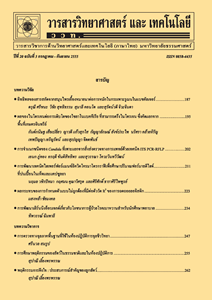บทบาทของแบคทีเรียร่วมอาศัยในแมลงและแนวทางการประยุกต์ใช้เพื่อการควบคุมแมลงศัตรู
Main Article Content
Abstract
บทคัดย่อ
แมลงหลายกลุ่มมีชีวิตอยู่ร่วมกับแบคทีเรียที่อยู่ภายในลำตัว ซึ่งมีความสัมพันธ์ต่อกันหลายรูปแบบ ตั้งแต่อยู่ร่วมกันแบบพึ่งพาอาศัยอย่างถาวร จนถึงแบบภาวะปรสิต แบ่งเป็นสองกลุ่มหลัก คือ กลุ่มที่อยู่ภายในเซลล์และนอกเซลล์ของแมลง แบคทีเรียร่วมอาศัยภายในเซลล์แบ่งเป็น 2 ประเภท ได้แก่ ประเภทปฐมภูมิ คือแบคทีเรียที่อยู่เฉพาะในส่วนของ bacteriome มีความจำเพาะกับกลุ่มหรือชนิดของแมลงอาศัย ความสัมพันธ์ร่วมกันแบบถาวร ได้รับประโยชน์ร่วมกัน แบคทีเรียมีบทบาทในการสังเคราะห์สารอาหารที่สำคัญให้กับแมลง และประเภททุติยภูมิ คือแบคทีเรียที่อาศัยอยู่ส่วนอื่น ๆ เช่น ทางเดินอาหาร เนื้อเยื่อที่เกี่ยวข้องกับระบบสืบพันธุ์ ไม่มีความจำเป็นต่อการดำรงชีวิตของแมลง อาจให้ประโยชน์หรือบางชนิดเป็นปรสิต อีกกลุ่มหนึ่งคือแบคทีเรียที่อาศัยภายนอกเซลล์ โดยอาศัยอยู่บริเวณลำไส้ บทบาทที่สำคัญคือ การย่อยอาหาร สังเคราะห์สารอาหาร ขจัดสารพิษ ปัจจุบันมีการศึกษาแนวทางการใช้แบคทีเรียร่วมอาศัยเพื่อควบคุมแมลงศัตรู เช่น การทำลายแบคทีเรียที่ให้ประโยชน์กับแมลง ส่งผลให้แมลงมีอัตราการเจริญและสืบพันธุ์น้อยกว่าปกติ การใช้แบคทีเรีย Wolbachia ชักนำให้เกิดการความผิดปกติในระบบสืบพันธุ์ มีผลทำให้อัตราการฟักของไข่ลดลง และการยับยั้งการถ่ายทอดเชื้อสาเหตุโรคในแมลงพาหะ โดยคัดแยกและดัดแปลงพันธุกรรมของแบคทีเรียร่วมอาศัย ให้เป็นตัวนำพายีนที่สามารถทำลายหรือยับยั้งการเจริญของเชื้อสาเหตุโรคที่อยู่ในตัวแมลง
คำสำคัญ : แบคทีเรียร่วมอาศัย; แมลง; บทบาทของแบคทีเรียร่วมอาศัยในแมลง; การควบคุมโดยใช้แบคทีเรียร่วมอาศัย
Abstract
Many insect groups rely on bacteria that live inside their body and there are various types of relationships, these could be range from mutualism to parasitism. Generally, bacteria symbionts in insects divided into two groups including intracellular and extracellular. The intracellular bacteria live inside the host’s cells and comprise with primary and secondary symbionts. Primary symbionts mean bacteria that live within specialized organ which called bacteriome. The kind of bacteria are specific with group or species of insect hosts and they are obligate mutualism association. The bacteria symbionts synthesis the essential nutrient for theirs hosts. Secondary symbionts are unlike primary, they live in another tissue such as in the gut or reproductive tissues. These bacteria symbionts are not required by insects, some groups benefit while some are parasites. Another one group is bacteria live outside insect cells; extracellular symbionts, they live in the gut or digestive tract of insect. Their roles are food digestion, provide nutrients, toxin detoxification. In recently, the application of bacterial symbionts for insect pests control has been investigated. For instance, disruption of the beneficial symbiont affect to reduction the host’s growth and development, the using of Wolbachia to induce the reproductive abnormality results in unhatched egg. In addition, the prevention of insect-borne disease by isolation and culture the bacterial symbiont, then genetically modify to be a vehicle for introduce the toxic gene which destroy a pathogen inside the insect vector.
Keywords: bacteria symbionts; insects; role of symbionts in insects; symbiotic control
แมลงหลายกลุ่มมีชีวิตอยู่ร่วมกับแบคทีเรียที่อยู่ภายในลำตัว ซึ่งมีความสัมพันธ์ต่อกันหลายรูปแบบ ตั้งแต่อยู่ร่วมกันแบบพึ่งพาอาศัยอย่างถาวร จนถึงแบบภาวะปรสิต แบ่งเป็นสองกลุ่มหลัก คือ กลุ่มที่อยู่ภายในเซลล์และนอกเซลล์ของแมลง แบคทีเรียร่วมอาศัยภายในเซลล์แบ่งเป็น 2 ประเภท ได้แก่ ประเภทปฐมภูมิ คือแบคทีเรียที่อยู่เฉพาะในส่วนของ bacteriome มีความจำเพาะกับกลุ่มหรือชนิดของแมลงอาศัย ความสัมพันธ์ร่วมกันแบบถาวร ได้รับประโยชน์ร่วมกัน แบคทีเรียมีบทบาทในการสังเคราะห์สารอาหารที่สำคัญให้กับแมลง และประเภททุติยภูมิ คือแบคทีเรียที่อาศัยอยู่ส่วนอื่น ๆ เช่น ทางเดินอาหาร เนื้อเยื่อที่เกี่ยวข้องกับระบบสืบพันธุ์ ไม่มีความจำเป็นต่อการดำรงชีวิตของแมลง อาจให้ประโยชน์หรือบางชนิดเป็นปรสิต อีกกลุ่มหนึ่งคือแบคทีเรียที่อาศัยภายนอกเซลล์ โดยอาศัยอยู่บริเวณลำไส้ บทบาทที่สำคัญคือ การย่อยอาหาร สังเคราะห์สารอาหาร ขจัดสารพิษ ปัจจุบันมีการศึกษาแนวทางการใช้แบคทีเรียร่วมอาศัยเพื่อควบคุมแมลงศัตรู เช่น การทำลายแบคทีเรียที่ให้ประโยชน์กับแมลง ส่งผลให้แมลงมีอัตราการเจริญและสืบพันธุ์น้อยกว่าปกติ การใช้แบคทีเรีย Wolbachia ชักนำให้เกิดการความผิดปกติในระบบสืบพันธุ์ มีผลทำให้อัตราการฟักของไข่ลดลง และการยับยั้งการถ่ายทอดเชื้อสาเหตุโรคในแมลงพาหะ โดยคัดแยกและดัดแปลงพันธุกรรมของแบคทีเรียร่วมอาศัย ให้เป็นตัวนำพายีนที่สามารถทำลายหรือยับยั้งการเจริญของเชื้อสาเหตุโรคที่อยู่ในตัวแมลง
คำสำคัญ : แบคทีเรียร่วมอาศัย; แมลง; บทบาทของแบคทีเรียร่วมอาศัยในแมลง; การควบคุมโดยใช้แบคทีเรียร่วมอาศัย
Abstract
Many insect groups rely on bacteria that live inside their body and there are various types of relationships, these could be range from mutualism to parasitism. Generally, bacteria symbionts in insects divided into two groups including intracellular and extracellular. The intracellular bacteria live inside the host’s cells and comprise with primary and secondary symbionts. Primary symbionts mean bacteria that live within specialized organ which called bacteriome. The kind of bacteria are specific with group or species of insect hosts and they are obligate mutualism association. The bacteria symbionts synthesis the essential nutrient for theirs hosts. Secondary symbionts are unlike primary, they live in another tissue such as in the gut or reproductive tissues. These bacteria symbionts are not required by insects, some groups benefit while some are parasites. Another one group is bacteria live outside insect cells; extracellular symbionts, they live in the gut or digestive tract of insect. Their roles are food digestion, provide nutrients, toxin detoxification. In recently, the application of bacterial symbionts for insect pests control has been investigated. For instance, disruption of the beneficial symbiont affect to reduction the host’s growth and development, the using of Wolbachia to induce the reproductive abnormality results in unhatched egg. In addition, the prevention of insect-borne disease by isolation and culture the bacterial symbiont, then genetically modify to be a vehicle for introduce the toxic gene which destroy a pathogen inside the insect vector.
Keywords: bacteria symbionts; insects; role of symbionts in insects; symbiotic control
Article Details
Section
Biological Sciences

